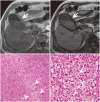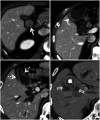Key Imaging Findings for the Prospective Diagnosis of Rare Diseases of the Gallbladder and Cystic Duct
- PMID: 34132078
- PMCID: PMC8390821
- DOI: 10.3348/kjr.2020.1479
Key Imaging Findings for the Prospective Diagnosis of Rare Diseases of the Gallbladder and Cystic Duct
Abstract
There are various diseases of the gallbladder and cystic duct, and imaging diagnosis is challenging for the rare among them. However, some rare diseases show characteristic imaging findings or patient history; therefore, familiarity with the imaging presentation of rare diseases may improve diagnostic accuracy and patient management. The purpose of this article is to describe the imaging findings of rare diseases of the gallbladder and cystic duct and identify their pathological correlations with these diseases.
Keywords: Granular cell tumor; Intracystic papillary neoplasm; Mucinous carcinoma; Multiseptate gallbladder; Tubular adenoma.
Copyright © 2021 The Korean Society of Radiology.
Conflict of interest statement
The authors have no potential conflicts of interest to disclose.
Figures














Similar articles
-
Intracholecystic papillary-tubular neoplasm of the gallbladder originating in the cystic duct with extensive intraepithelial progress in the common bile duct.Clin J Gastroenterol. 2019 Jun;12(3):197-204. doi: 10.1007/s12328-018-0927-4. Epub 2018 Nov 30. Clin J Gastroenterol. 2019. PMID: 30506287
-
[Squamous cell carcinoma of the gallbladder complicating a cystic dilation of the cystic duct and common bile duct: a case report].Pan Afr Med J. 2021 Feb 9;38:144. doi: 10.11604/pamj.2021.38.144.22684. eCollection 2021. Pan Afr Med J. 2021. PMID: 33912314 Free PMC article. French.
-
Early-stage T1b adenocarcinoma arising in the remnant cystic duct after laparoscopic cholecystectomy: a case report and literature review.BMC Surg. 2019 Nov 29;19(1):183. doi: 10.1186/s12893-019-0647-9. BMC Surg. 2019. PMID: 31783817 Free PMC article. Review.
-
Positive cystic duct margin at index cholecystectomy in incidental gallbladder cancer is an important negative prognosticator.Eur J Surg Oncol. 2019 Jun;45(6):1061-1068. doi: 10.1016/j.ejso.2019.01.013. Epub 2019 Jan 24. Eur J Surg Oncol. 2019. PMID: 30704808
-
Double cancer of the cystic duct and gallbladder associated with low junction of the cystic duct.J Hepatobiliary Pancreat Surg. 2008;15(3):338-43. doi: 10.1007/s00534-007-1245-2. Epub 2008 Jun 6. J Hepatobiliary Pancreat Surg. 2008. PMID: 18535776 Review.
Cited by
-
Pyloric Gastric Adenoma: Endoscopic Detection, Removal, and Echoendosonographic Characterization.ACG Case Rep J. 2023 Dec 21;10(12):e01229. doi: 10.14309/crj.0000000000001229. eCollection 2023 Dec. ACG Case Rep J. 2023. PMID: 38130477 Free PMC article.
References
-
- Whittle C, Skoknic V, Maldonado I, Schiappacasse G, Pose G. Multimodality imaging of congenital variants in the gallbladder: pictorial essay. Ultrasound Q. 2019;35:195–199. - PubMed
-
- Nakazawa T, Ohara H, Sano H, Kobayashi S, Nomura T, Joh T, et al. Multiseptate gallbladder: diagnostic value of MR cholangiography and ultrasonography. Abdom Imaging. 2004;29:691–693. - PubMed
-
- Goshima S, Chang S, Wang JH, Kanematsu M, Bae KT, Federle MP. Xanthogranulomatous cholecystitis: diagnostic performance of CT to differentiate from gallbladder cancer. Eur J Radiol. 2010;74:e79–e83. - PubMed
-
- Kang TW, Kim SH, Park HJ, Lim S, Jang KM, Choi D, et al. Differentiating xanthogranulomatous cholecystitis from wall-thickening type of gallbladder cancer: added value of diffusion-weighted MRI. Clin Radiol. 2013;68:992–1001. - PubMed
Publication types
MeSH terms
LinkOut - more resources
Full Text Sources
Medical

